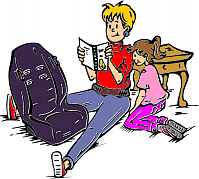|
Car Time
|
 |
At Stage 3, your child should weighs at least 18 kg (40 pounds), and may be about
4 1/2 years old. Your child is now ready to use a booster seat. The booster seat will
keep the seat belt in the correct place over your child’s body. You must use the seat
belt to hold the booster seat and child in place.
If you use a booster seat when your child is too small, your child could be hurt during a sudden stop or if your car
is in a crash.
|
TP14339E
ISBN 0-662-30083-1
Cat. T46-29/1-2001E
Revised March 2006

|
|
|
When to use a booster seat:
- Only use a booster seat for children who weigh at least 18 kg (40 pounds).
- Use the booster seat each time you go out in the car with your child.
Top
|
How to use a booster seat:
- Choose a booster seat that fits your child and your vehicle.
- Read the instructions for your vehicle and read the instructions
that came with the booster seat. This will help you to place your child in
the booster correctly. You also need to be sure you are using the correct
seat belt system with the booster seat.
|

Highback Booster
|
|
- The back seat is the safest place for your child.
- Always put the shoulder belt over the shoulder and across the chest. Never put the shoulder belt behind
the child’s back or under the arm. This could cause a serious injury if there is a crash.
- Always put the lap belt low and snug across the hips. Never let the lap belt ride up over the child’s stomach.
This could cause a serious injury if there is a crash.
- Buckle up an empty booster seat with the seat belt so it won’t move around.
Top
|
|
When to replace a booster seat:
- Replace the booster seat if your car is in a crash. You should do this even if your child was not riding in the
booster seat during the crash.
- When it reaches the expiry date.
- If there is no expiry date, replace a seat that is ten years old.
|

"No Back" Booster
|
|
Top
Contact Us:
For questions about your car seat, please contact the manufacturer. For more information or to order more copies of this publication,
contact:
Transport Canada at:
1-800-333-0371, by email: roadsafetywebmail@tc.gc.ca
Health Canada at:
(613) 952-1014, by fax: (613) 941-4376 or by email: cps-spc@hc-sc.gc.ca
Top
You can also download "Car
Time - Stage 3: Safe Travel in a Booster Seat" (PDF
format, 77Kb).
To view PDF documents you must use Adobe® Acrobat Reader. Visit the
Adobe site to download the latest, free version.
If you need an alternative format or for more information, please contact us by e-mail at
RoadSafetyWebMail@tc.gc.ca
or call toll free 1-800-333-0371 (Ottawa area (613) 998-8616).
|

